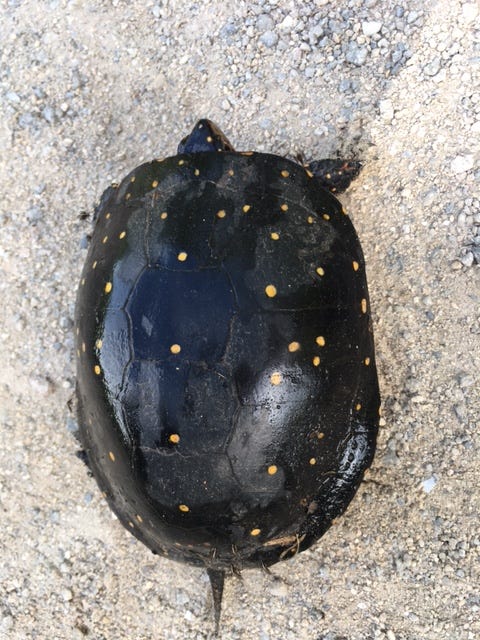I decided to look through my archives for things that made me happy. Even though my encounter with this spotted turtle was nearly two years ago, I remember the (one-sided) conversation we had as I tried to convince him to get off the road.
Hope the article and the short video cheer you up too.
There's more to conservation than flowers and bugs. We share this planet with countless creatures we will never meet or even know exist. However, they're just as important as the more visible beings we're around daily. All creatures, great and small, must be treated with respect and dignity.
I never knew there was such a thing as a spotted turtle until I came across the little guy in the middle of our road. The sandy surface may have offered a comfortable spot to relax in the shade, but it wasn't safe. The way some frustrated wanna-be race drivers consider secondary roads as their private dirt track didn't bode well for me to leave the turtle where it was.
Astonishingly, it wasn't as shy as the common box or snapping turtles I generally see hanging out along the roadside. They usually retreat into their shells and allow me to pick them up and move them into the grass without any fuss.
Not this guy. He watched every move I made as I snapped pictures and complimented him on the nice paint job on his shell. When I reached down to pick him up, he refused to come quietly. Instead, the turtle gave me the evil eye as I grasped the sides of his shell. Then he squirmed out of my hands and ran away. That surprised me! Not the evil eye so much but the agility and speed at which he moved. He was quite fast.
I took the hint and didn't try a second time. Since the turtle didn't want to be carried, a few taps with my foot gently persuaded him to move to the shoulder. After the little guy disappeared amongst the overgrown vegetation bordering the ditch, I waved goodbye and continued on my way.
Later on, my research on Spotted Turtles yielded some very interesting information. Spotted turtles are small, aquatic turtles, named for the yellow polka dots scattered across their dark shells. The species occur in wetlands throughout the east coast and in the Great Lakes region of the United States and is threatened by the loss, alteration, and fragmentation of this habitat. Climate change has the potential to impact the hydrology of the wetlands the species depends upon over time. Poaching and collection for the foreign and domestic pet trade also pose a threat for spotted turtle populations. (US Fish and Wildlife Service) https://www.fws.gov/species/spotted-turtle-clemmys-guttata
I wish I'd spent more time taking pictures of this threatened turtle. Wow! I feel privileged to have seen, talked to, and photographed a beautiful creature people rarely encounter.
I must admit, I'd never been a big fan of the deep ditches crisscrossing the local countryside, mainly because they're prime mosquito-breeding territory. When I realized how many other creatures depend on the waterways, though, I changed my way of thinking. Predatory insects such as dragonflies require the same wet, marshy conditions, and they eat the skeeters, as do the fish and frogs living in the ditches. We can't forget the herons and other waterfowl that drop by to feed on the insects, frogs, and fish.
This habitat is vital for turtles as well. They need clean, shallow bodies of standing or slow-flowing water with muddy or mucky bottoms and aquatic vegetation. At night and during hot weather, they burrow under vegetation or into the soil or muddy bottoms of the wetland or crawl into mammal burrows. They overwinter in shallow water, mud, mammal burrows, or lodges.
Even though they are aquatic, turtles, including the spotted variety, also spend time on land, especially during mating and nesting seasons. That's when they're more vulnerable to forces outside of nature, i.e., crossing paths with humans and our mechanized contraptions.
Conservation biologist James Gibb says, "Turtle populations in the Northeast, Southeast, and Great Lakes region suffer at least a 10 percent annual kill rate from road kills, and some of these regions likely have up to 20 percent mortality rates due to traffic encounters." Unfortunately, at those rates, turtle species are vanishing in some regions.
We've got to look out for these innocent creatures as they navigate across the terrain. They're clueless about roads and traffic. Please, keep an eye out for turtles (and other critters) while you're driving. Here are some tips for helping a turtle cross the road.
~~~~~~~~~~~~~~~~~~~~~~~~~~
I would be grateful if you would Buy Me a Brownie. Your gift will help me as I spread my love for Mother Nature.
Dear Reader,
I'd be ever so grateful if you would take a few minutes to recommend Let's Get Our Hands Dirty to your followers on Substack and other social media platforms.
Thank you!
Greta
Let's Get Our Hands Dirty is a reader-supported publication. This post is free as are all my posts. Please subscribe so you can receive notifications when new articles are published. I'd love for you to become a part of our nature-loving family. Basic subscriptions are free, but if you sign up for a paid subscription as a love offering, that would be greatly appreciated!
Have a fabulous day,
Greta
Please use the buttons below to Like, Comment, Restack, and Share my post on Substack and other social media platforms.
THANK YOU SO MUCH!







I love this!
Many years ago, when I was less informed, and our kids were little we came across a painted turtle crossing the road. We thought it would be educational for our daughter, who loves all animals, to take it home for the summer. We placed it in a small wading pool, with a platform and sand and water. Little did we know she was on her way to lay her eggs and had to do that in that pool. I was so dismayed when we realised that. She laid 8 eggs. We did our best to rescue them and went on the internet so see how we might still have them hatch. One of them did. We were home when it happened and the kids were able to watch. We did all we could to set up an aquarium and learned all we could about care and feeding. All went well for a few years but it did not grow well, which we didn't realise. When it began to grow blind we consulted a turtle vet and discovered that UV lights lose their UV rays long before the light actually dims. Imagine our guilt. We had done our best but it wasn't good enough. It was a sad lesson about leaving nature well enough alone unless there is obvious risk. Our interference is rarely a good thing.